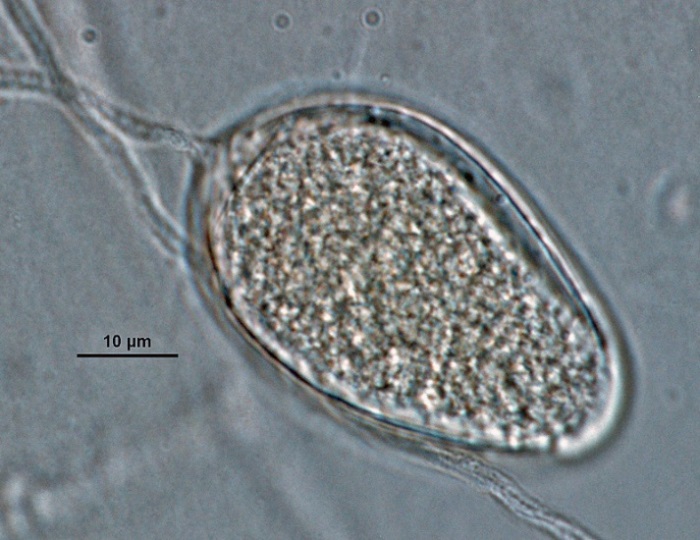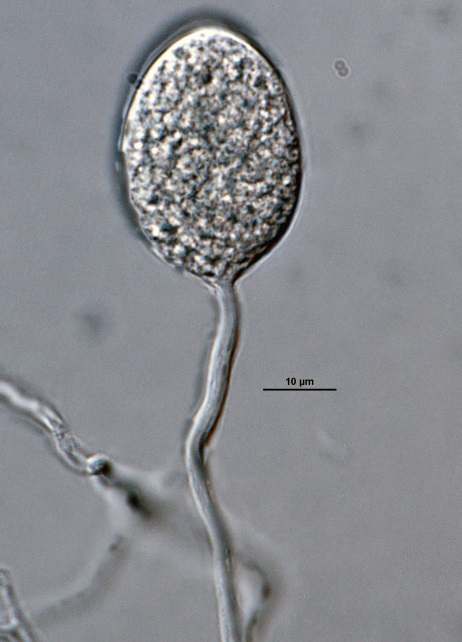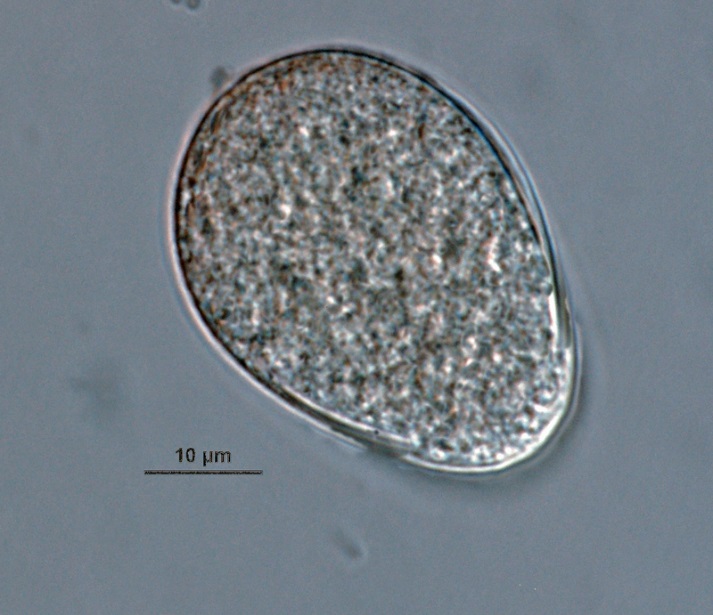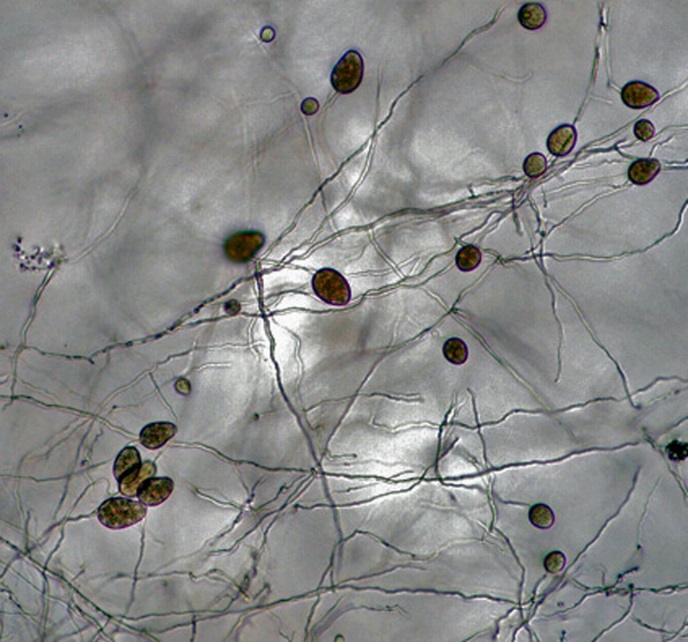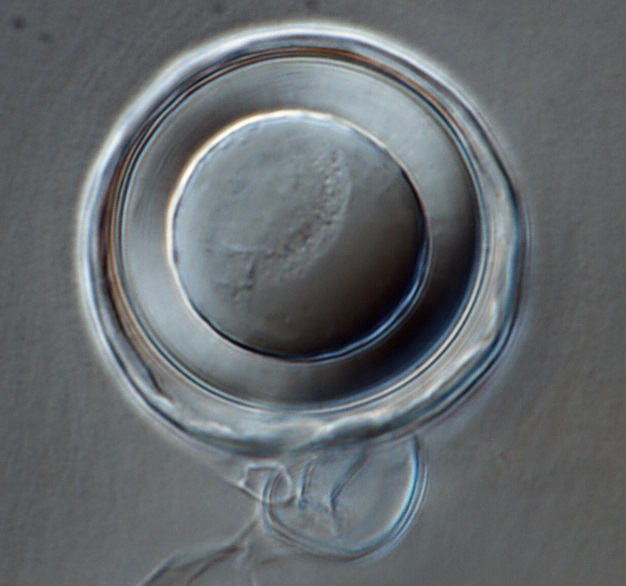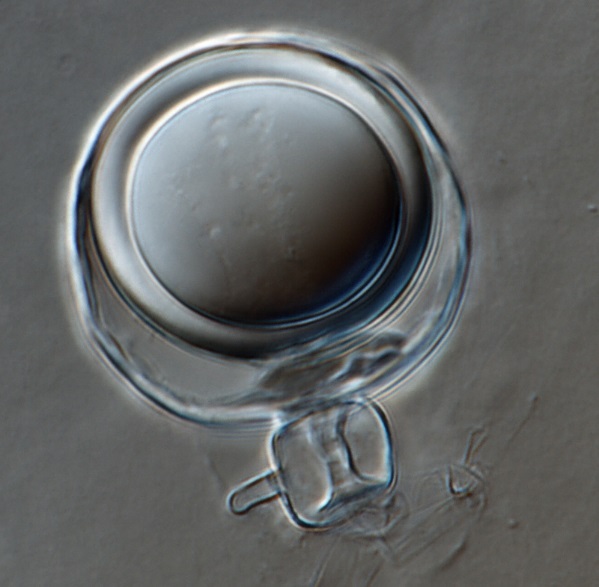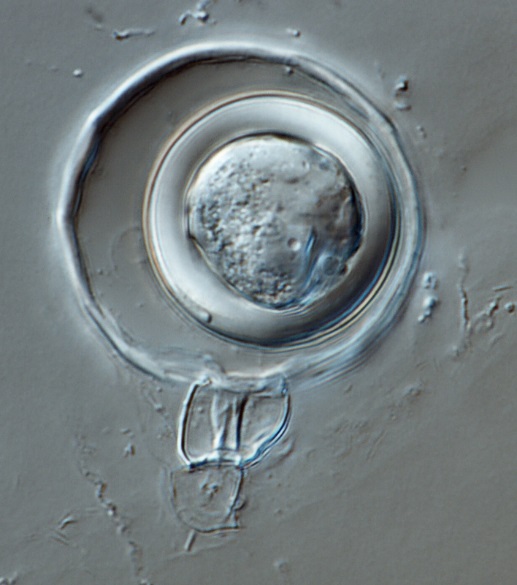Phytophthora erythroseptica (in progress - Abad et al. 2023b)
|
Phytophthora spp. in subclade 8a: portion of the seven-loci ML phylogeny featuring the type cultures of 212 described species (by T. Bourret). Notice the position of P. erythroseptica selected specimen CBS 148925 = S&T BL 80. Gloria Abad, USDA S&T.
|
|
Phytophthora spp. in subclade 8a: Morphological Tabular key (PDF) and Tabular key legends (PDF) in IDphy2 KEY SECTION. Notice the data of P. erythroseptica selected specimen CBS 148925 = S&T BL 80. Gloria Abad, USDA S&T.
|
|
Phytophthora erythroseptica (CPHST BL 80) colonies of the ex-epitype grown for 7 days on (a) V8® Agar, (b) potato dextrose agar, and (c) malt extract agar; photo by Krysta Jennings and Leandra Knight, USDA-APHIS-PPQ |
|
Phytophthora erythroseptica (CPHST BL 36G) colonies of a selected specimen grown for 7 days on (a) V8® Agar, (b) potato dextrose agar, and (c) malt extract agar; photo by Krysta Jennings and Leandra Knight, USDA-APHIS-PPQ |
|
Phytophthora erythroseptica (CPHST BL 36G, selected specimen) asexual phase: (a-g) sporangia nonpapillated produced in simple sympodial (b-d) or in unbranched sporangiophores (e, g); photos by Gloria Abad, USDA-APHIS-PPQ. |
|
Phytophthora erythroseptica (CPHST BL 36G, selected specimen) sexual phase: (a-d) oogonia with amphigynous antheridia and aplerotic oospores, (b) antheridium with digitate projection; photos by Gloria Abad, USDA-APHIS-PPQ |
|
pink rot of potatoes caused by Phytophthora erythroseptica, photo from Le Plant de Pomme de Terre - Francais, The French Industry |
|
Phytophthora erythroseptica (CPHST BL 36G, selected specimen) asexual phase: sporangia nonpapillated produced in simple sympodial sporangiophores; photo by Gloria Abad, USDA-APHIS-PPQ. |
|
Phytophthora erythroseptica (CPHST BL 36G, selected specimen) asexual phase: sporangia nonpapillated produced in simple sympodial sporangiophores; photo by Gloria Abad, USDA-APHIS-PPQ. |
|
Phytophthora erythroseptica (CPHST BL 36G, selected specimen) asexual phase: sporangium nonpapillated produced in unbranched sporangiophore; photo by Gloria Abad, USDA-APHIS-PPQ. |
|
Phytophthora erythroseptica (CPHST BL 36G, selected specimen) asexual phase: sporangium nonpapillated produced in unbranched sporangiophore; photo by Gloria Abad, USDA-APHIS-PPQ. |
|
Phytophthora erythroseptica (CPHST BL 36G, selected specimen) asexual phase: sporangium nonpapillated produced in unbranched sporangiophore; photo by Gloria Abad, USDA-APHIS-PPQ. |
|
Phytophthora erythroseptica (CPHST BL 36G, selected specimen) asexual phase: sporangia nonpapillated produced in simple sympodial sporangiophores; photo by Gloria Abad, USDA-APHIS-PPQ. |
|
Phytophthora erythroseptica (CPHST BL 36G, selected specimen) asexual phase: sporangia nonpapillated produced in simple sympodial sporangiophores; photo by Gloria Abad, USDA-APHIS-PPQ. |
|
Phytophthora erythroseptica (CPHST BL 36G, selected specimen) sexual phase: oogonium with amphigynous antheridium and aplerotic oospore; photo by Gloria Abad, USDA-APHIS-PPQ. |
|
Phytophthora erythroseptica (CPHST BL 36G, selected specimen) sexual phase: oogonium with amphigynous antheridium and aplerotic oospore; photo by Gloria Abad, USDA-APHIS-PPQ. |
|
Phytophthora erythroseptica (CPHST BL 36G, selected specimen) sexual phase: oogonium with amphigynous antheridium with digitate projection and aplerotic oospore; photo by Gloria Abad, USDA-APHIS-PPQ. |
|
Phytophthora erythroseptica (CPHST BL 36G, selected specimen) sexual phase: oogonium with amphigynous antheridium and aplerotic oospore; photo by Gloria Abad, USDA-APHIS-PPQ. |
Name and publication
Phytophthora erythroseptica Pethybr. (1913)
Pethybridge GH. 1913. On the rotting of potato tubers by a new species of Phytophthora having a method of sexual reproduction hitherto undescribed. Scientific Proceedings of the Royal Dublin Society 13: 529–565 (pgs. 547-548).
Nomenclature
Mycobank
Typification
from Pethybridge (1913)
Type: IRELAND, causing tuber-rot of potato, first observed in 1909 at Cliffden Co, Galway. Studies of the pathogen were conducted in 1912 and the name Phytophthora erythroseptica was proposed, and for the disease the name "pink rot" was suggested.
NOTES: IMI 34684,VKM F-1807 G.H. Pethybridge (LOST).
The following isolates cited as ex-type correspond to Phytophthora cryptogea: CBS 129.23 (referred as the type strain), P1693 (WPC), P3916 (WPC), P3453 (WPC); ATCC 58104, H14.1 (Hong), 61J2 (Yang)
Well-authenticated specimen(s) selected by Gloria Abad:
selected specimen #1: CPHST BL 80 = P6180 (WPC) from IRELAND, isolated from potato (Solanum tuberosum), collected in Banon, Dublin in 1989
selected specimen #2: CPHST BL 36G = P0340 (WPC) from TASMANIA, isolated from potato (Solanum tuberosum)
Selected specimen in other collections
(SE) CBS 148925, NRRL 64171, WPC P6180, S&T BL 80 (Abad)
Molecular identification
Voucher sequences for barcoding genes (ITS rDNA and COI) of the selected specimen (see Molecular protocols page)
Phytophthora erythroseptica isolate CPHST BL 80 (= P6180 WPC) = ITS rDNA MG865486, COI MH136882
Phytophthora erythroseptica isolate CPHST BL 36G (= P0340 WPC) = ITS rDNA MG865487, COI MH136883
Voucher sequences for Molecular Toolbox with seven genes (ITS, β-tub, COI, EF1α, HSP90, L10, and YPT1
(see Molecular protocols page) (In Progress)
Voucher sequences for Metabarcoding High-throughput Sequencing (HTS) Technologies [Molecular Operational Taxonomic Unit (MOTU)]
(see Molecular protocols page) (In Progress)
Sequences with multiple genes for selected specimen in other sources
- NCBI: Phytophthora erythroseptica CPSHT BL 80
- NCBI: Phytophthora erythroseptica P6180
- EPPO-Q-bank: Phytophthora erythroseptica
- BOLDSYSTEMS: Phytophthora erythroseptica (barcoding COI & ITS)
Note: NCBI: Phytophthora erythroseptica 61J2 sequences cited as ex-type are incorrect. They align with Phytophthora cryptogea (see above).
Position in multigenic phylogeny with 7 genes (ITS, β-tub, COI, EF1α, HSP90, L10, and YPT1)
Clade 8a
Morphological identification
Colonies and cardinal temperatures
Colony colony:
assemblage of hyphae which usually develops form a single source and grows in a coordinated way
morphology after 7 days on V8-A with no distinct pattern; on PDA and MEA with slight chrysanthemum pattern. Minimum growth temperature 6°C, optimum 21°C, and maximum 30°C.
Asexual phase
Sporangia nonpapillated; persistentpersistent:
pertaining to sporangia that remain attached to the sporangiophore and do not separate or detach easily (cf. caducous)
; ellipsoidellipsoid:
refers to a solid body that forms an ellipse in the longitudinal plane and a circle in cross section; many fungal spores are ellipsoidal or elliptic
, obpyriformobpyriform:
inversely pear-shaped, i.e. with the widest part at the point of attachment (cf. pyriform)
, ovoidovoid:
egg-shaped, with the widest part at the base of the sporangium and the narrow part at the apex
(23–87 x 14–36 μm), with rounded and tapered bases, ellipsoidellipsoid:
refers to a solid body that forms an ellipse in the longitudinal plane and a circle in cross section; many fungal spores are ellipsoidal or elliptic
frequently constricted in the middle; internal, external and nested proliferationnested proliferation:
a type of internal proliferation where a new sporangium develops successively inside the old sporangium after it has emptied
is observed. SporangiaSporangia:
sac within which zoospores form, especially when water is cooled to about 10°C below ambient temperature; in solid substrates, sporangia usually germinate by germ tubes
produced in unbranched or simple sympodial sporangiophores. Hyphal swellings are common. ChlamydosporesChlamydospores:
an asexual spore with a thickened inner wall that is delimited from the mycelium by a septum; may be terminal or intercalary, and survives for long periods in soil
absent.
Sexual phase
Homothallic. OogoniaOogonia:
the female gametangium in which the oospore forms after fertilization by the antheridium
with smooth wall, spherical (24–42 μm diam.); antheridiaantheridia:
the male gametangium; a multinucleate, swollen hyphal tip affixed firmly to the wall of the female gametangium (the oogonium)
predominantly amphigynousamphigynous:
pertaining to the sexual stage in which the antheridium completely surrounds the stalk of the oogonium (cf. paragynous)
(10–18 x 12–16 μm), some with spine or digitate projections and apleroticaplerotic:
pertaining to a mature oospore that does not fill the oogonium; i.e. there is room left between the oospore wall and oogonium wall (cf. plerotic)
oospores (20–31 μm diam.).
Most typical characters
Phytophthora erythroseptica is characterized by the presence of sporangiasporangia:
sac within which zoospores form, especially when water is cooled to about 10°C below ambient temperature; in solid substrates, sporangia usually germinate by germ tubes
often with a constriction distal to the middle and some amphigynousamphigynous:
pertaining to the sexual stage in which the antheridium completely surrounds the stalk of the oogonium (cf. paragynous)
antheridia with spine or digitate projections.
Specimen(s) evaluated
Phytophthora erythroseptica CPHST BL 80, duplicate of P6180 (World Phytophthora Collection)
Phytophthora erythroseptica CPHST BL 36G, duplicate of P0340 (World Phytophthora Collection)
Hosts and distribution
Distribution: cosmopolitan
Substrate: roots, seeds, leaves, petioles, tubers
Disease note: Pink rot of potato tubers is a serious pathogen of Solanaceae and other crops. Commonly a root rot, also damping-off, seedling rot, wilt crown rot, leaf and petiole blight.
Hosts: principal hosts: Solanaceae; also on 15 other genera in 10 other families
Retrieved January 29, 2018 from U.S. National Fungus Collections Nomenclature Database.
Additional references and links
The French Industry. Leak and Pink Rot (Pythium and Phytophthora erythroseptica). Le Plant de Pomme de Terre - Francais.
- SMML USDA-ARS: Phytophthora erythroseptica
- EPPO Global Database: Phytophthora erythroseptica
- Forest Phytophthoras of the world: Phytophthora erythospeptica
- CABI Digital Library: Phytophthora erythospeptica
- Encyclopedia of Life (EOL): Phytophthora erythroseptica
- Index Fungorum (IF): Phytophthora erythroseptica
- Google All Phytophthora erythroseptica
- Google Images Phytophthora erythroseptica
- Google Scholar Phytophthora erythroseptica
Fact sheet author
Z. Gloria Abad, Ph.D., USDA-APHIS-PPQ-S&T Plant Pathogen Confirmatory Diagnostics Laboratory (PPCDL), United States of America.



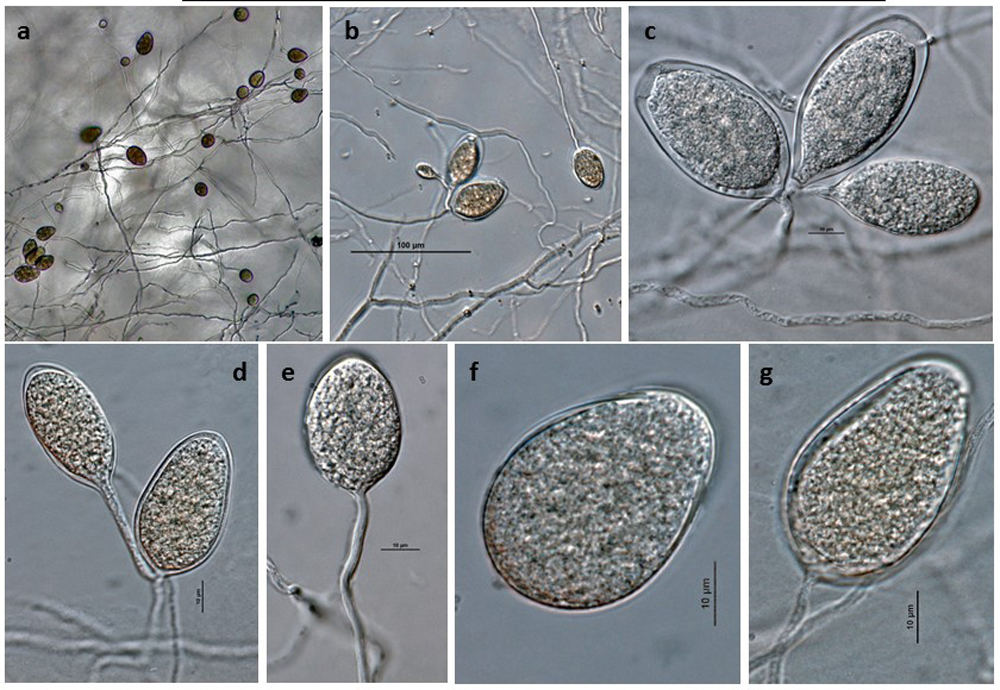

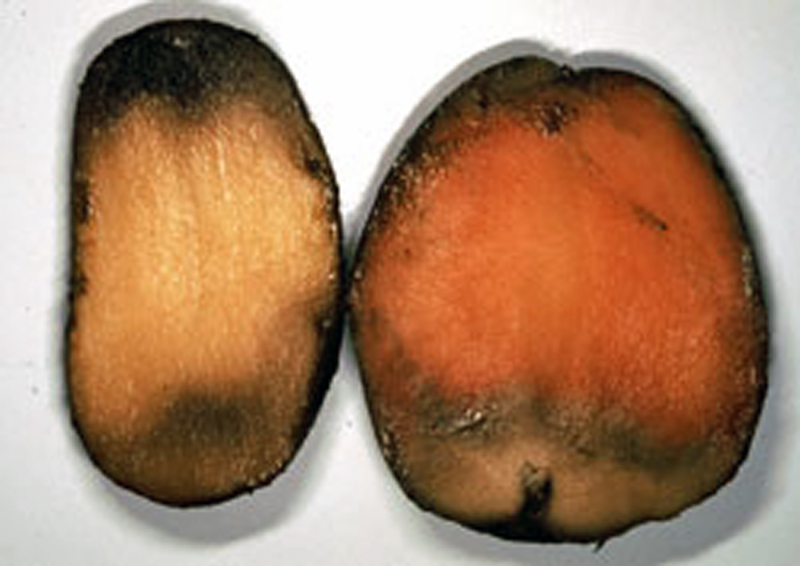
.jpeg)

